A study performed by B2B Marketing concluded that 66% of marketers found case studies to the most effective piece of content.
Why is this so?
For starters, case studies are typically used as middle or bottom-of-the-funnel content.
This means that the users reading it has already found your brand, trusts it, but now needs one final push before becoming a customer.
Case studies help these users convert by showcasing the results you’ve delivered for previous clients and relating to their problems.
I’m going to teach you how to write a case study, examples you can learn from, and more in this case study copywriting tutorial so you can generate more leads.
What is a case study?
According to the Merriam Webster dictionary, a case study is:
an intensive analysis of an individual unit (such as a person or community) stressing developmental factors in relation to environment.
In other words, it’s a breakdown of how a business faced a problem, solved it, and what the readers can learn from it to replicate the results.
Case studies aren’t just used in business, but for practically any other purpose. This includes academia and science, for example.
You can also look at them as a way to tell a story that is driven by data, statistics, and real world examples.
Potential clients that read them can relate to the issues the business faced, and this is what spikes them to reach out to you.
Please keep in mind that case studies are not blog posts, ads, or press releases. Sure, you will obviously need to cover what you did to help the client, but don’t make it seem like one giant advertisement for you.
Case study copywriting
Writing a good case study takes planning and research.
I’ve laid out the steps you will need to take to produce an effective case study below.
Step 1: Decide on a client to focus the case study on
The first step is to determine which client you would like to write a case study about.
The client should be one that you generated significant results for, and that other leads could relate to the most.
For example, if you’re a B2B lead gen agency and target mostly finance companies, don’t write a case study on the one health business you worked with.
You want the case study to resonate with the main buyer’s persona of your business.
Once you have decided on the client, you then need to ask for permission. Some businesses may not want the publicity, or others know they outsourced certain operations.
This is why you must reach out to them with an email like:
Hey {First name},
{Company name} is interested in writing a new case study, and thought the project we did together would be a perfect fit.
This would be a great way for {Clients company} to gain further exposure, and all we require is your company logo, company images, and before/after metrics.
Would you be interested in hopping on a phone call this week to chat about the details?
I’d love to explain the process and what’s in it for you.
Warm regards,
{Name}
If all goes well, you will be able to get a decision-maker on the phone to talk about how the case study will play out.
Ask them questions, such as:
- What issue did your business face that caused you to reach out to us? What were the symptoms?
- What made you choose us over other service providers?
- What impact did you notice our service had on your business performance?
- What goals and KPIs does your business have?
- Do you give us permission to share data and metrics of your company in the case study?
Step 2: Research and write the case study
Before you begin writing, you need to research and plan the case study thoroughly.
The discovery call you made earlier should give you heaps of information to work with.
Always reach out to the client with questions or if you need further resources.
This brings me to the first section of the outline.
Title and introduction
The intro of a case study needs to introduce the client’s company. Speak about what products they sell, the industry they’re in, what their goals are, and company size.
You will also need an exciting title that will get leads interested in reading the case study itself. I’d recommend making a title that includes:
- The name of the client
- The result you helped bring
- A statistic
This would look something like:
- How We Helped Microsoft Increase MRR By 31%
- Content Marketing Generates IBM 250 New Leads Every Month
- Our Social Media Campaign Made Pepsi Go Viral And Make $1M in Sales
Magento is an excellent example of how to write case study headlines:

The introduction should also cover what the readers will learn in the case study as a whole. Feel free to provide some birds-eye level statistics and information — but don’t give too much away — you want them to keep reading.
Check out my guide to headline copywriting to learn more.
That same case study from Magento also boasts a good example of an introduction.
It’s short and straight to the point. A paragraph is usually more than enough to cover the essentials as they did.
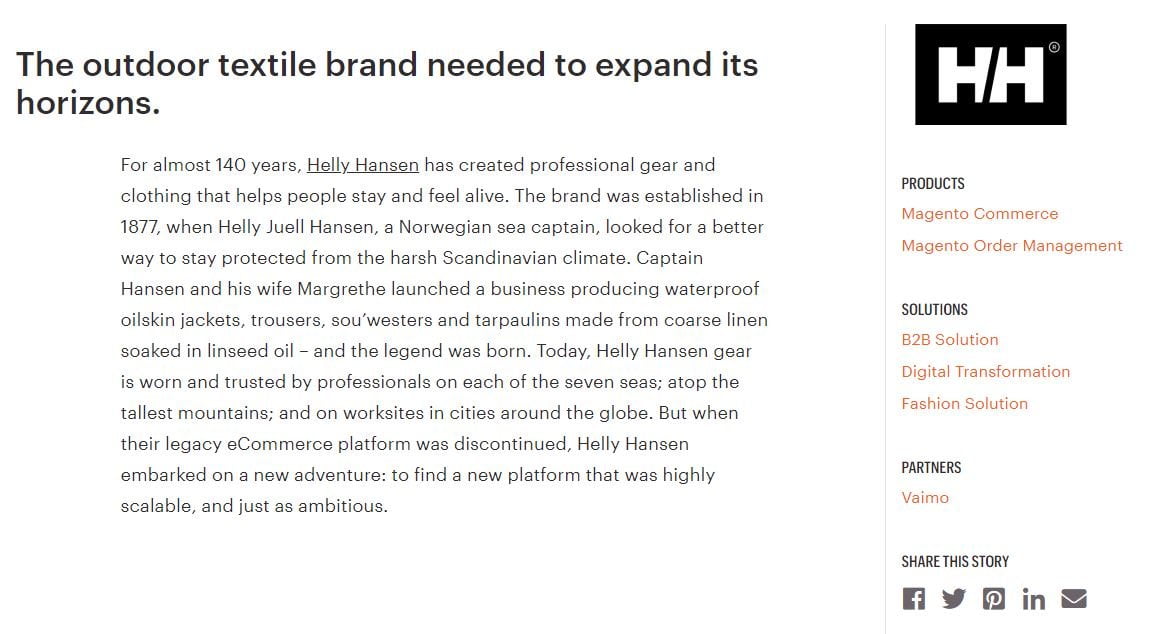
What’s the problem?
One of the most important sections of a case study is where you detail the problem your client faced. Go into great detail, as well.
Outline the top few issues they experienced and what they manifested as, such as low amounts of leads, organic traffic, engagement, etc.
Here you can also tie in the goals of the client, and what they wished to fix before moving on to the next part.
Denamico did a good job doing this in one of their lead generation case studies.
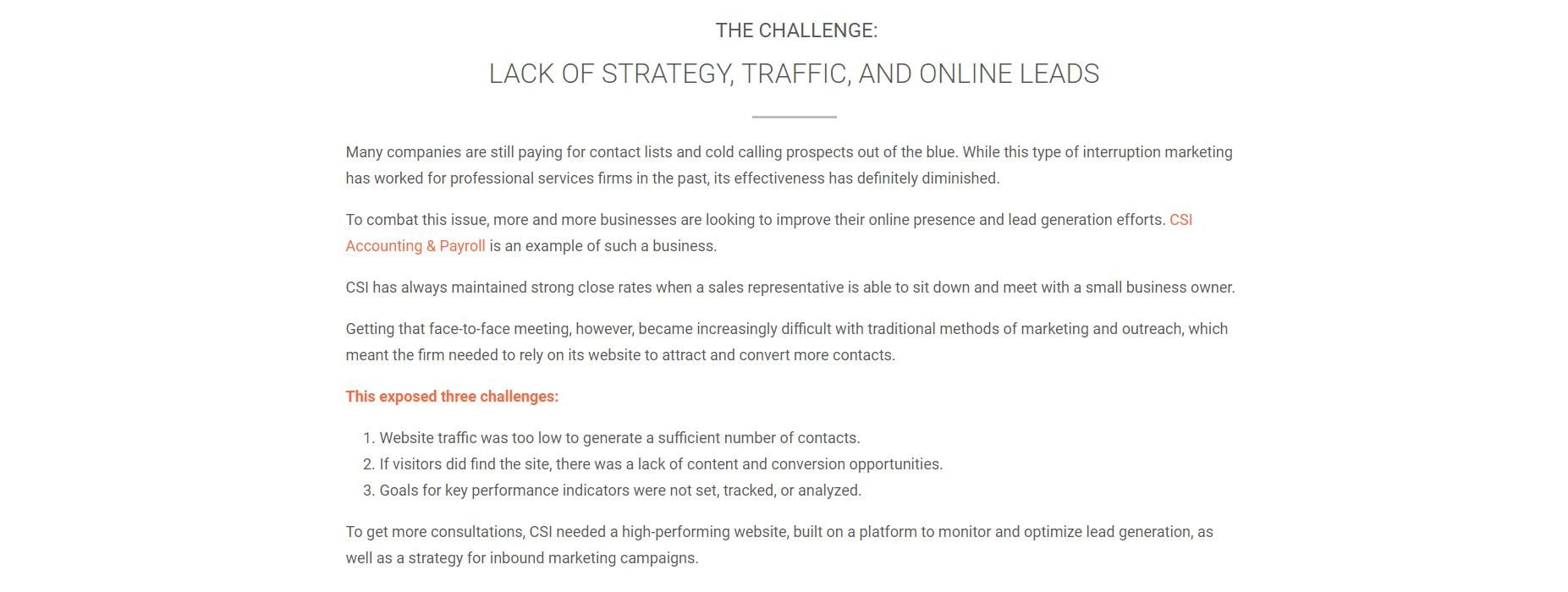
How’d you solve it?
Just as if your client was a damsel in distress, show that you were the knight in shining armour.
After the introduction and problem are clearly defined, you can then elaborate on the steps you took to solve the client’s situation.
Explain how you audited their business and developed a plan for success. Detail how you executed and measured every step, too.
What was the outcome?
Now for the fun part of the case study: the results!
This is what leads are truly interested in when reading a case study anyways.
Go into great detail about the results that your services created for the client.
If you are able to get screenshots, metrics, and data from before and after, that’s icing on the cake.
Brightedge schools us how to create a simple but effective case study but outlining the results they yielded for a client in just text.

You don’t need fancy graphics and images if you don’t want to, as the data speaks for itself.
Other effective case study copywriting strategies you must use
These are other copywriting strategies you can use to improve the ROI of case studies.
Use stories to burn copy into the reader’s brain
Stories turn our brains into mush. We love them.
They gain our attention and get us drooling for more.
Why is this?
For starters, cognitive scientists have discovered that reading or hearing stories activate the motor cortex in our brains.

This is the part of the brain responsible for planning, controlling, and exciting physical movements.
That means if you read a story that talks about how “John ran three miles in the snow,” your brain would fire the motor cortex to move your legs.
Crazy, huh?
It doesn’t stop there.
Reading words that describe foods or scents will light up the part of the brain responsible for the sense of smell. That’s why if you visualize something hard enough, it’s almost as if you can taste, smell, and feel it. 🧠
Where does all of this play into case study copywriting?
Simple.
I want you to implement stories as often as possible about the client in case studies.
Don’t just say that they had low conversions and revenue was sinking to the bottom of the ocean.
Talk about how the low conversions stressed them out, the events leading up to it, how they almost had to fire their best staff, the sleepless nights, etc.
Jennifer Aaker, a professor of marketing at Standford, stated that stories are 22x more memorable than general facts.
You are making case studies much more memorable for potential clients, and guess what?
When they are looking for a solution, they’ll come to you!
In fact, 64% of respondents in a Demand Gen reported that they share case studies with colleagues.
If it stands out, it’ll land on the right person’s desk.
Optimize that bad boy for search engines
Do you want to rank on the first page of Google and get mountains of visitors? 📊
Of course.
You must optimize case studies for SEO with this in mind.
The major step you need to take is keyword research.
Keywords are words and phrases that you want to be discovered for. I recommend using search terms that involve an industry, problem, or solution followed by “case study” like:
- Lawyer marketing case study
- SaaS SEO case study
- Startup lead generation case study
Try using a tool like Moz’s Keyword Explorer.

This is what we call an informational keyword. The user is trying to find information about a certain topic.
Inform them as much as possible using the previous methods I outlined in this article to achieve that.
These types of keywords are also near the end of the buyer journey.
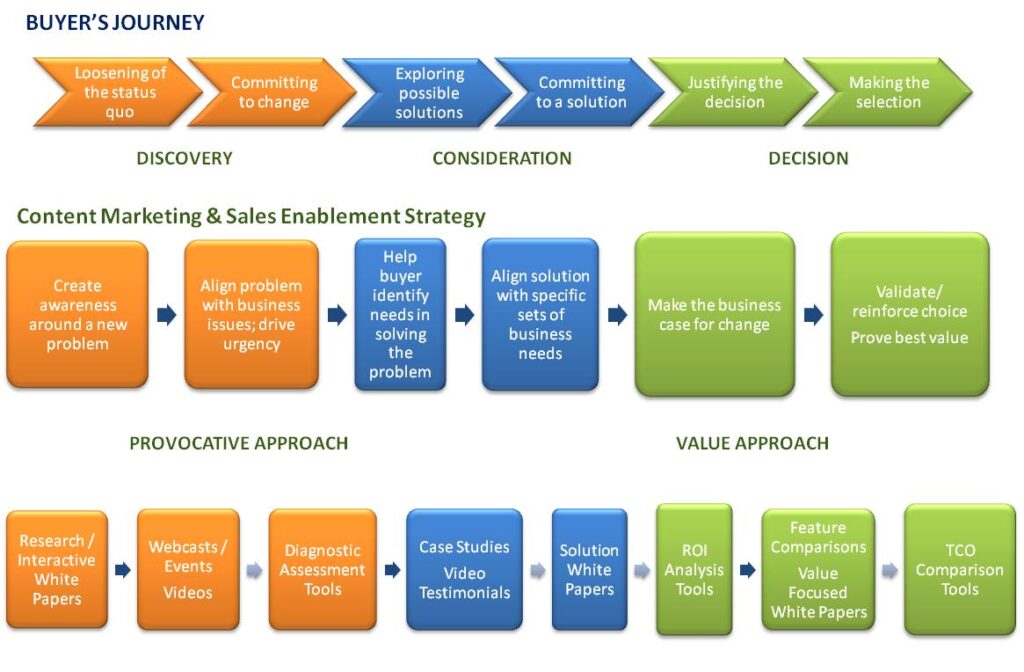
A prospect has already discovered they have a problem, weighed their options, and now they’re looking for a solution.
Where should keywords be placed? In the following areas:
- Headline
- URL
- Meta description
- Alt text of images
- File names of media
- Header tags
- Body text
- Introduction
- Conclusion
Congratulations, your case study is optimized for its target keyword. 🙂
Put your case study to work!
After you’ve written an epic case study, it’s easy to keep up your feet and think you’re done.
Not so fast…
Your job has really just begun.
It’s now time to get the case study in front of the right people.
“But, Carmine! I thought you said I’ll rank on the first page of Google and get traffic that way?”
Sure, eventually.
In the meanwhile, I want you to promote and repurpose the case study.
It should be distributed through the following channels:
- Social media (Facebook, LinkedIn, Twitter, etc.)
- Social media groups.
- Email newsletters.
- Content syndication websites.
- Relevant subreddits like /r/entrepreneur.
- Physical mail.
- Outbound sales like cold emailing.
This will get it in front of the widest possible audience.
You can also take snippets of the case study, like quotes and statistics, to share as standalone pieces of content.
Then, repurpose that puppy.
Turn the case study into a video … podcast …. blog post … you name it.
This maximizes your content marketing efficiency.
You put all of that effort into the case study and easily spin it off into 10+ other assets.
Read my guide to repurposing content to learn more.
Business case study examples
Now that you understand how to write a case study, let’s look at some examples of case studies for further inspiration.
Rock & Roll Hall of Fame and HubSpot

Who would’ve thought that the Rock & Roll Hall of Fame would be using marketing automation?
The team at the Rock & Roll Hall of Fame had been executing a marketing strategy consisting of outreach and engaging with fans but knew they needed something more refined.
That’s why they began using HubSpot’s platform to streamline the process and had amazing results. Do you know what’s more amazing, though? The case study they wrote.
Landing on the page gives you an overview of the case study, the client, and how HubSpot helped. This is a nice summary you can include, as well.
Below this, you immediately see the numbers related to the case study with a quick profile of the client on the right.
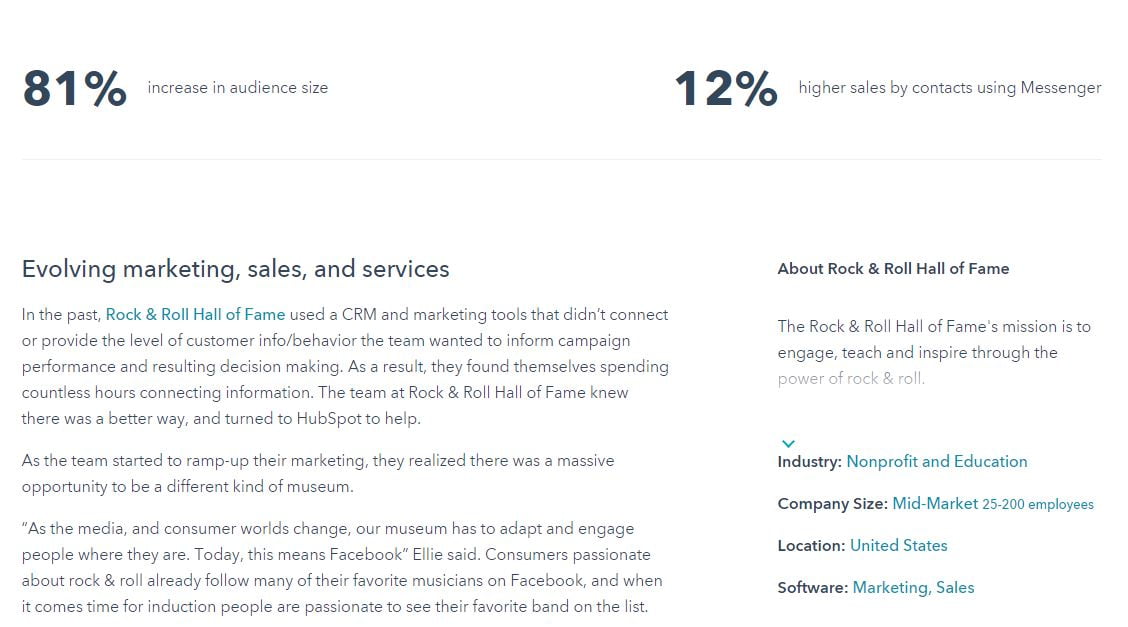
Leads reading the case study will be excited by seeing data like this because it implies the service provider, HubSpot, in this case, can drive real-world results.
The profile is a nice touch, too, because it gives leads a better idea of they relate to the case study.
Note how the introduction of the case study also touches on the pain points that the Rock & Roll Hall of Fame was experiencing and what made them use HubSpot to begin with.
The remaining case study goes in-depth on how the client and service provider teamed up to create respectable results in revenue and conversion rates.
Remember that some of the main goals of case studies are to display how you’ve helped businesses and the associated numbers. Go in-depth as HubSpot did about the steps you took to solve your client’s issues.
Brightedge and Adobe

Brightedge is a digital marketing agency, and Adobe is one of the leading software companies in the world.
Despite Adobe’s large reach, they noticed that their organic traffic was beginning to slow down and needed a helping hand.
I love the case study they did above because that’s it. What you see is what you get.
As soon as you land on the page, the entire case study is visible above the fold.
Note how there is a download button at the top in case the reader wants to digest it later or share it with colleagues.
The picture of one of Adobe’s employees with a quote adds a personalized touch to the case study, as well.
Brightedge uses the standard format of addressing the problem their client faced, how they solved it, and the results generated.
You don’t need the fanciest and most in-depth case study to generate leads and get potential clients interested.
I’ll be touching more on good case study formatting like this later in the article.
Sprout Social and Cloudera
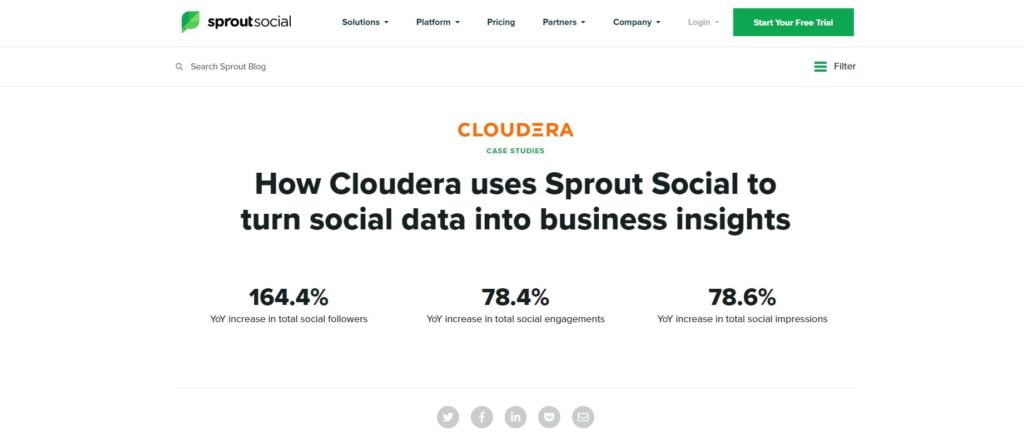
Sprout Social, the social media marketing agency, paired up with Cloudera to sharpen their social data.
Cloudera needed a more efficient way to create, publish, and manage its social media content while analyzing its performance.
That’s why they turned to Sprout Social.
The results the agency developed for their client are right in your face as soon as you land on the page, giving you a sneak peek of what’s ahead.
Social sharing buttons also create the opportunity for the case study to go viral and get seen by more people free of cost.
They also include quotes from employees within Cloudera to act as social proof.

Using a standard case study format, Sprout Social first touches on the problems their client was experiencing.
Two more sections after this touch on how Cloudera used different features of the Sprout Social platform to increase the performance of their social campaigns.
You can do the same by mentioning precise features and products your client used in case studies you write if you want to promote specific ones.
Case study format
So, how should you format a case study?
There are many ways you can write a case study to make it irresistible to leads, but here’s one bulletproof formula you can use…
Start with the problem
Every case study needs to begin by describing the client’s problems for two reasons.
One, this allows leads to relate to the case study as they may very likely be facing the same issues within their company. This will heighten their attention.
Similarly, talking about problems delivers emotion and, once again, gets the reader hooked.
Case studies that focus on a problem most of your clients face are ideal. This is because it will resonate more with your buyer persona.
If you publish a case study that talks about a problem one in a hundred of your clients has, it might not have the best conversion rate because it’s not relatable.
This brings me to my next point.
Talk about how you’re the hero in the story
With the problem outlined, the next step is to elaborate on how you solved it.
A.K.A. explain how you are the knight in shining armor for the client.
This is a very important part of a case study as it allows you to brag about your process, workflow, and efficiency.
Go in-depth as much as possible about how your service or solution resolved the issues your client was facing.
Adding quotes in this section is effective as they act as testimonials.
Talk some numbers, baby
Did you increase revenue? Upped the conversion rate of a PPC campaign?
Whatever you did for the client, be very specific with numbers.
You’ll notice that all of the case studies I shared earlier that they shove stats in your face.
This is because businesses want results; thus, sharing the exact numbers helps with converting readers into high-quality leads.
It’s also brilliant to include these stats at the very beginning of the case study as a teaser.
Final thoughts on case study copywriting
Case studies are effective pieces of content for generating leads.
It all begins with reaching out to a previous client, asking for permission to use them for a case study, and conducting an interview.
Gather as much information and resources from them as possible, then create an outline for the case study. It should have a convincing intro with sections on the problem, solution, and results.
Take the first step today and reach out to one of your past clients to begin the case study writing process!
Check out my online courses and templates if you want to be a better case study copywriter.














